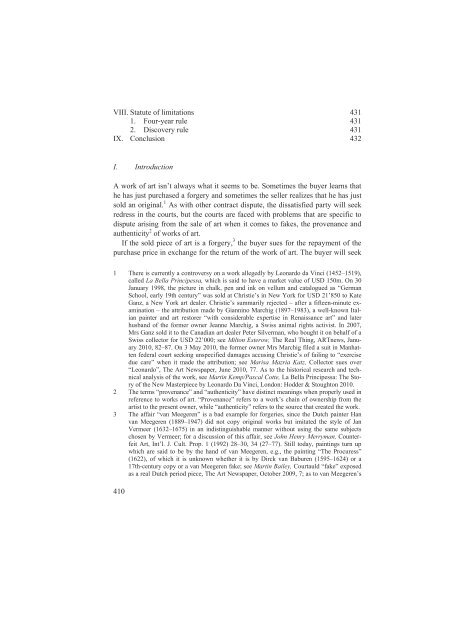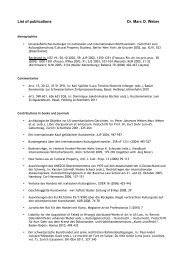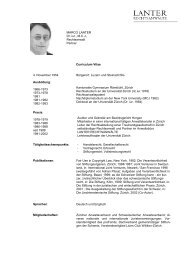Liability for the Acquisition of Faked or Wrongly Attributed Works of ...
Liability for the Acquisition of Faked or Wrongly Attributed Works of ...
Liability for the Acquisition of Faked or Wrongly Attributed Works of ...
You also want an ePaper? Increase the reach of your titles
YUMPU automatically turns print PDFs into web optimized ePapers that Google loves.
VIII. Statute <strong>of</strong> limitations 431�<br />
1.� Four-year rule 431�<br />
2.� Discovery rule 431<br />
IX. Conclusion 432�<br />
I. Introduction<br />
A w<strong>or</strong>k <strong>of</strong> art isn’t always what it seems to be. Sometimes <strong>the</strong> buyer learns that<br />
he has just purchased a <strong>f<strong>or</strong></strong>gery and sometimes <strong>the</strong> seller realizes that he has just<br />
sold an <strong>or</strong>iginal. 1 As with o<strong>the</strong>r contract dispute, <strong>the</strong> dissatisfied party will seek<br />
redress in <strong>the</strong> courts, but <strong>the</strong> courts are faced with problems that are specific to<br />
dispute arising from <strong>the</strong> sale <strong>of</strong> art when it comes to fakes, <strong>the</strong> provenance and<br />
au<strong>the</strong>nticity 2 <strong>of</strong> w<strong>or</strong>ks <strong>of</strong> art.<br />
If <strong>the</strong> sold piece <strong>of</strong> art is a <strong>f<strong>or</strong></strong>gery, 3 <strong>the</strong> buyer sues <strong>f<strong>or</strong></strong> <strong>the</strong> repayment <strong>of</strong> <strong>the</strong><br />
purchase price in exchange <strong>f<strong>or</strong></strong> <strong>the</strong> return <strong>of</strong> <strong>the</strong> w<strong>or</strong>k <strong>of</strong> art. The buyer will seek<br />
1 There is currently a controversy on a w<strong>or</strong>k allegedly by Leonardo da Vinci (1452–1519),<br />
called La Bella Principessa, which is said to have a market value <strong>of</strong> USD 150m. On 30<br />
January 1998, <strong>the</strong> picture in chalk, pen and ink on vellum and catalogued as “German<br />
School, early 19th century” was sold at Christie’s in New Y<strong>or</strong>k <strong>f<strong>or</strong></strong> USD 21’850 to Kate<br />
Ganz, a New Y<strong>or</strong>k art dealer. Christie’s summarily rejected – after a fifteen-minute examination<br />
– <strong>the</strong> attribution made by Giannino Marchig (1897–1983), a well-known Italian<br />
painter and art rest<strong>or</strong>er “with considerable expertise in Renaissance art” and later<br />
husband <strong>of</strong> <strong>the</strong> <strong>f<strong>or</strong></strong>mer owner Jeanne Marchig, a Swiss animal rights activist. In 2007,<br />
Mrs Ganz sold it to <strong>the</strong> Canadian art dealer Peter Silverman, who bought it on behalf <strong>of</strong> a<br />
Swiss collect<strong>or</strong> <strong>f<strong>or</strong></strong> USD 22’000; see Milton Esterow, The Real Thing, ARTnews, January<br />
2010, 82–87. On 3 May 2010, <strong>the</strong> <strong>f<strong>or</strong></strong>mer owner Mrs Marchig filed a suit in Manhatten<br />
federal court seeking unspecified damages accusing Christie’s <strong>of</strong> failing to “exercise<br />
due care” when it made <strong>the</strong> attribution; see Marisa Mazria Katz, Collect<strong>or</strong> sues over<br />
“Leonardo”, The Art Newspaper, June 2010, 77. As to <strong>the</strong> hist<strong>or</strong>ical research and technical<br />
analysis <strong>of</strong> <strong>the</strong> w<strong>or</strong>k, see Martin Kemp/Pascal Cotte, La Bella Principessa: The St<strong>or</strong>y<br />
<strong>of</strong> <strong>the</strong> New Masterpiece by Leonardo Da Vinci, London: Hodder & Stoughton 2010.<br />
2 The terms “provenance” and “au<strong>the</strong>nticity” have distinct meanings when properly used in<br />
reference to w<strong>or</strong>ks <strong>of</strong> art. “Provenance” refers to a w<strong>or</strong>k’s chain <strong>of</strong> ownership from <strong>the</strong><br />
artist to <strong>the</strong> present owner, while “au<strong>the</strong>nticity” refers to <strong>the</strong> source that created <strong>the</strong> w<strong>or</strong>k.<br />
3 The affair “van Meegeren” is a bad example <strong>f<strong>or</strong></strong> <strong>f<strong>or</strong></strong>geries, since <strong>the</strong> Dutch painter Han<br />
van Meegeren (1889–1947) did not copy <strong>or</strong>iginal w<strong>or</strong>ks but imitated <strong>the</strong> style <strong>of</strong> Jan<br />
Vermeer (1632–1675) in an indistinguishable manner without using <strong>the</strong> same subjects<br />
chosen by Vermeer; <strong>f<strong>or</strong></strong> a discussion <strong>of</strong> this affair, see John Henry Merryman, Counterfeit<br />
Art, Int’l. J. Cult. Prop. 1 (1992) 28–30, 34 (27–77). Still today, paintings turn up<br />
which are said to be by <strong>the</strong> hand <strong>of</strong> van Meegeren, e.g., <strong>the</strong> painting “The Procuress”<br />
(1622), <strong>of</strong> which it is unknown whe<strong>the</strong>r it is by Dirck van Baburen (1595–1624) <strong>or</strong> a<br />
17th-century copy <strong>or</strong> a van Meegeren fake; see Martin Bailey, Courtauld “fake” exposed<br />
as a real Dutch period piece, The Art Newspaper, October 2009, 7; as to van Meegeren’s<br />
410





